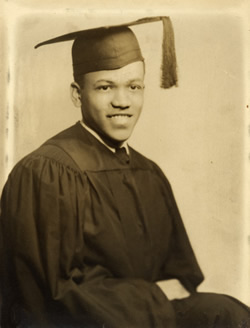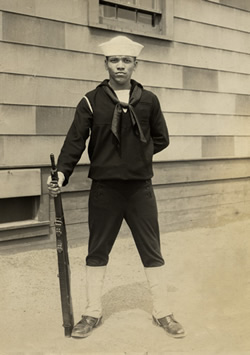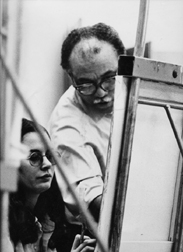Reginald Gammon
Biography
Reginald A. Gammon, Jr., was born March 31, 1921 in Philadelphia, Pennsylvania to Reginald and Martha Brown Gammon and died on November 4th, 2005 in Albuquerque, New Mexico, at the age of 84. Gammon was an exceptional teacher, painter and printmaker. An intellectual artist, his work depicted the civil rights struggles of the 1960's, the dignity of unsung heroes, jazz and blues musicians and observations of everyday life.
After graduating from high school in 1941, Gammon received a scholarship to study art at the Philadelphia Museum College of Art (then called the Philadelphia Museum School of Industrial Arts). The following summer, Gammon worked at the Philadelphia Naval Shipyard refurbishing battleships for the war effort, but that job caused him to lose his scholarship. For the next 18 months, he worked at the shipyards during the day and went to art school at night. With the arrival of his draft notice, Gammon joined the Navy and served from 1944-46 with an all black unit stationed in Guam. After the war, he returned to Philadelphia. Though offered a five-year scholarship at Tyler School of Fine Arts, he turned it down so he could help support his family. In 1948, after two years of working and going to school, he left Philadelphia and moved to New York City. To support himself, Gammon took jobs that ranged from sorting mail for the US Post Office, to painting lampshades, to designing advertisement copy for Liften, Gold and Asher. He devoted his evenings and weekends to painting. It was at this time that he met Janice Goldberger (Jonni), whom he later married in 1972.
In 1963, Gammon was invited to join Spiral, a group of African American artists that included Romare Bearden, Richard Mayhew, Hale Woodruff and Alvin Hollingsworth. Named for the Archimedean geometric construct, the purpose of Spiral was to stimulate an on-going exchange of evolving ideas. In 1965, Spiral held its only group exhibition at the Christopher Street Gallery in New York City. Called "Black and White" this show was a pointed statement about the civil rights movement. The exhibit pieces, all in various shades of black and white, included Gammon's Freedom Now and Bearden's Mysteries. The group disbanded shortly afterwards. In 1969, Gammon and Benny Andrews formed the Black Emergency Cultural Coalition. This highly political group of artists picketed the Metropolitan Museum of Art and the Whitney Museum of Modern Art to protest the exclusion of black artists and curators at both institutions.
About this time, Gammon landed a teaching job as an "art expert" with the New York public schools. Teaching in the Saturday Academy Program, Gammon set up an informal studio so that children from Harlem could work with resident artists. This opportunity opened other doors when his friend Hughie Lee-Smith recommended him for a visiting lectureship at Western Michigan University in Kalamazoo, Michigan. Quickly realizing the contributions Gammon could make to the University's "Arts and Ideas" program, Humanities faculty asked the Dean to extend the 10-day lectureship to a one-semester teaching contract. Beginning January 1, 1970, this four-month position ended 21 years later with his retirement in 1991 as Full Professor Emeritus of Fine Arts and Humanities.
Moving to Albuquerque, New Mexico in 1992, Gammon quickly became immersed in the local art community. Gammon joined the New Mexico Afro-American Artist Guild and the Albuquerque United Artists. He participated in Afro-American Guild exhibits and was their treasurer from 1999 until his death. He was artist-in-residence from 1992-2005 at the Harwood Art Center where he had a painting studio. Gammon was one of the founding members of New Grounds Print Workshop & Gallery (1996) where he renewed his love for printmaking. He developed his last body of work, a collection of over 100 prints of historically important jazz musicians and gospel singers, at New Grounds.
Janet Yagoda Shagam, PhD


